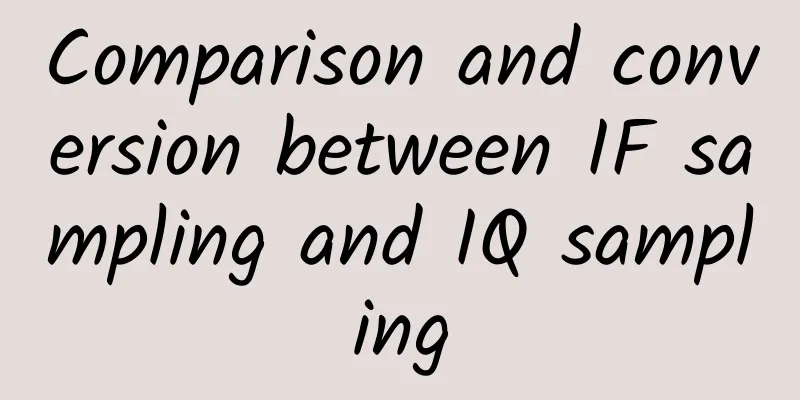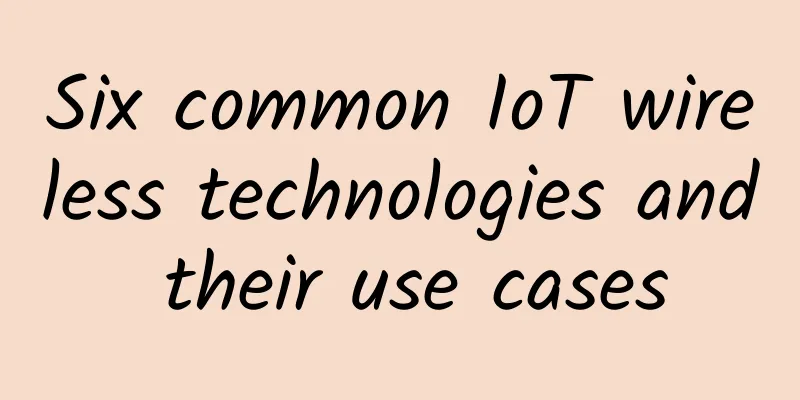Comparison and conversion between IF sampling and IQ sampling

|
RF receiving systems usually use digital signal processing algorithms for signal demodulation and analysis, so an ADC is needed to sample the signal. Depending on the sampling frequency, it can be divided into RF direct sampling, intermediate frequency sampling, and IQ sampling. RF sampling and intermediate frequency sampling only require one ADC, and the sampling result is a set of digital sequences, while IQ sampling requires two ADCs, and the sampling result is two sets of digital sequences. Intermediate frequency sampling has lower requirements on ADC bandwidth and sampling rate than RF sampling. At the same time, the intermediate frequency of broadband receivers is generally a fixed frequency, so intermediate frequency sampling is widely used. The main principle block diagram of intermediate frequency sampling is as follows: Figure 1. IF sampling block diagram IQ sampling can provide IQ two-way data commonly used in digital signal demodulation and analysis algorithms, and is also widely used. The main principle block diagram of IQ sampling is as follows: Figure 2. IQ sampling block diagram Comparison between IF sampling and IQ samplingThe main differences between IF sampling and IQ sampling include the carrier frequency of the sampling signal, the number of sampling channels, and the sampling rate. Take a signal with an IF frequency of 70MHz and a bandwidth of 10MHz as an example to compare the two sampling methods. The carrier frequency of the IF signal is IF (70MHz in the example), the lowest frequency is IF-BW/2 (65MHz in the example), and the highest frequency is IF+BW/2 (75MHz in the example). The IQ signal is a baseband signal with no carrier, the lowest frequency is DC, and the highest frequency is BW/2 (5MHz in the example). If both use low-pass sampling and the sampling rate is at least twice the highest frequency of the analog signal, the lowest sampling rate of IF sampling is 2*IF+BW (150MHz in the example), and the lowest sampling rate of IQ sampling is BW (10MHz in the example). It can be seen that the sampling rate of IQ sampling is lower. Even considering the factor of two-way sampling, the amount of data is still smaller, so it has advantages in signal acquisition storage and digital signal processing. However, the IQ sampling hardware structure is more complex, and IQ sampling has very high requirements on hardware performance. Ideal IQ sampling requires that the amplitudes of the two signals are equal (i.e., the IQ two channels are balanced) and the phases differ by 90 degrees (i.e., the IQ two channels are orthogonal). It is difficult for actual hardware to meet the two-channel balance and orthogonality requirements of IQ sampling, which will introduce additional performance degradation. In order to avoid the performance degradation caused by the imbalance and non-orthogonality of the IQ sampling hardware, there is a method of first sampling at the intermediate frequency and then using digital down-conversion to obtain IQ data, which can be regarded as a combination of intermediate frequency sampling and IQ sampling. Common intermediate frequency sampling and IQ sampling in instrumentsEngineers have many purposes for sampling signals, which may be for signal demodulation and analysis, or for signal reproduction. For example, if a device works abnormally in a certain electromagnetic environment, the electromagnetic environment signal can be collected and stored by an instrument, and the collected data can be brought back to the laboratory and reproduced using an instrument. Engineers may use instruments that use IQ sampling data or IF sampling data during signal acquisition and playback. If you do not understand the difference between the two, it is easy to make mistakes. A signal and spectrum analyzer is a common RF signal acquisition instrument. A signal and spectrum analyzer generally has an analog intermediate frequency output interface, which can be connected to an acquisition card for sampling. The data obtained is single-channel intermediate frequency sampling data, and the carrier frequency is the intermediate frequency of the spectrum analyzer. The advantage of this method is that the acquisition time can be very long, and the acquisition time is determined by the acquisition card. At the same time, many signal and spectrum analyzers also have the ability to save IQ sampling data files, and the saved data files are two-channel IQ sampling data (it may be one file, but the data is two-channel data, for example, stored in the form of IQIQIQ). Generally, the IQ sampling data files saved by signal and spectrum analyzers have fewer sampling points. Vector signal source is a common signal playback instrument. Generally, vector signal source requires data files in IQ sampling format for signal playback. If single-channel intermediate frequency sampling data is played back using vector signal source, there will be a mismatch problem. To solve this problem, there are two options:
Method 1 is relatively simple, while method 2 requires certain digital signal processing capabilities. The main disadvantages of method 1 are:
Therefore, method 2 is a more ideal choice. Conversion between IF sampling data and IQ sampling dataThe process of converting IQ sampling data into intermediate frequency sampling data is actually the process of realizing IQ modulation by mathematical operations, which only requires simple addition and multiplication operations. IF_Signal = I_signal*cos(a) + Q_signal*sin(a) It should be noted that: since the sampling rate of IQ sampling is very low, the sampling rate of intermediate frequency sampling needs to be higher. Before performing addition and multiplication operations, it may be necessary to increase the sampling rate of IQ data. You can use Matlab's resampling function resample(x,P,Q) to increase the sampling rate. Converting IF sampling data to IQ sampling data is relatively more complicated. IF sampling data can be converted to IQ sampling data through digital down-conversion. The main principle block diagram is as follows: Figure 3. Block diagram of digital down-conversion of IF sampling signal The main process of converting intermediate frequency sampling data to IQ sampling data includes: digital down-conversion, filtering, and decimation. Decimation refers to the process of reducing the sampling rate. Since IQ sampling requires a lower sampling rate, decimation is generally included. Using the digital down-conversion function dsp.DigitalDownConverter in Matlab's digital signal processing toolkit, the intermediate frequency sampling signal can be easily converted to an IQ sampling signal. The key parts of the reference code for converting intermediate frequency sampling data into IQ sampling data using Matlab are as follows: clear;%Construct a digital down-conversion function with a decimation factor of 2, an intermediate frequency of 50MHz, a filter bandwidth of 20MHz, and an in-band ripple of 0.5dB. The following is a comparison of the signal spectrum before and after data conversion, mainly the shift of the carrier frequency. The carrier frequency is converted from the intermediate frequency to DC. The spectrum of the original intermediate frequency sampling data, the intermediate frequency is 50MHz: Figure 4: IF sampling signal spectrum After conversion, the IQ sampling signal spectrum has no carrier frequency, as shown in the following figure: Figure 5. Spectrum after conversion to IQ sampling |
<<: Experts gather between REST, gRPC and GraphQL!
>>: This article will help you understand the technical principles of CDN!
Recommend
Mobile edge computing provides unlimited possibilities for 5G innovation
At the "2017 China MEC Industry Development ...
Interviewer: What are the common HTTP request headers?
[[401820]] This article is reprinted from the WeC...
Lisa Host: Los Angeles Cera Data Center CN2 High Defense VPS monthly payment starts at 40 yuan, support 2 yuan/day trial
I shared information about Lisa hosts in the midd...
80VPS 50% off all VPS, Hong Kong CN2 line KVM monthly payment starts from 45 yuan
80VPS has launched a 50% discount coupon this mon...
CMIVPS: Hong Kong large bandwidth/US AS4837 line VPS host monthly payment 20% off/annual payment 30% off
CMIVPS is a Chinese hosting company founded in 20...
CloudSilk VPS in Tokyo, Japan is now online, with annual payment of CMI for three-network backhaul starting from 360 yuan
CloudSilk has launched a VPS host in Tokyo, Japan...
[11.11] LOCVPS top up 100 yuan and get 10 yuan, all hosts are 60% off, Hong Kong VPS monthly payment starts from 22 yuan
LOCVPS officially announced the promotion during ...
Goodbye 2G, hello 5G
[[403376]] This article is reprinted from the WeC...
South Korea's 5G users approach 10 million, with mixed results for the future
As the first country in the world to announce the...
Does Overlay require RDMA and Segment Routing?
In the past few years, there have been some debat...
How does 5G promote innovation in manufacturing?
5G technology is revolutionizing the way we commu...
Sharktech: $59/month 1Gbps unlimited traffic server, E3-1270v2/16GB/500G SSD/Los Angeles high defense
Sharktech's two promotional machines this mon...
Have you fallen for the rumors and scams about 5G?
Since the birth of mankind, cutting-edge technolo...
How 5G and WiFi 6 will impact critical sensor applications
We live in an age where wireless communications a...









